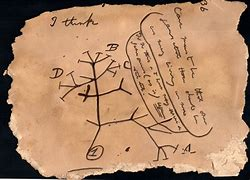Genesis 1:24
"The “tree of life,” a branching pattern of evolutionary diversification, was the only illustration in Darwin’s Origin of Species. In 1859, it only existed in his imagination as he speculated, with only circumstantial evidence based on similarities, that all living things descended from a common ancestor. The fossil record did not show such a tree. Darwin expected the record would be filled in by subsequent discoveries.
He could not have anticipated the revolution in genomics of the 20th century. Neo-Darwinists met these discoveries with great anticipation that Darwin’s tree of life would now become visible in the genetic codes impressed in the cell of every organism. Richard Dawkins predicted in A Devil’s Chaplain (2003, p. 272),
We are now at a stage where enough data have been published, including complete genomes of dozens of plants and animals, such that an assessment is now possible to see if a tree is coming into focus. In addition, we have decades of comparative studies of proteins from different organisms. A status report of sorts was published this week by Antonis Rokas and Sean B. Carroll in PLoS Biology. Though they began with Dawkins’ optimistic prophecy, the news is not good. They see multiple bushes, not a tree. These two evolutionary biologists admit that not only is a tree pattern indecipherable, it may never become visible, even as more data are added:
--This frank admission by two believers in common ancestry demonstrates that molecular genetics has not delivered the hoped-for pattern: “Obtaining an accurate depiction of the evolutionary history of all living organisms has been and remains one of biology’s great challenges.”
“The observed conflicts are not dependent on the optimality criterion used,” they said. The problem is real, and it’s pervasive."
David F. Coppedge/CEH
"The “tree of life,” a branching pattern of evolutionary diversification, was the only illustration in Darwin’s Origin of Species. In 1859, it only existed in his imagination as he speculated, with only circumstantial evidence based on similarities, that all living things descended from a common ancestor. The fossil record did not show such a tree. Darwin expected the record would be filled in by subsequent discoveries.
He could not have anticipated the revolution in genomics of the 20th century. Neo-Darwinists met these discoveries with great anticipation that Darwin’s tree of life would now become visible in the genetic codes impressed in the cell of every organism. Richard Dawkins predicted in A Devil’s Chaplain (2003, p. 272),
…there is, after all, one true tree of life, the unique pattern of evolutionary branchings that actually happened. It exists. It is in principle knowable. We don’t know it all yet. By 2050 we should – or if we do not, we shall have been defeated only at the terminal twigs, by the sheer number of species.
We are now at a stage where enough data have been published, including complete genomes of dozens of plants and animals, such that an assessment is now possible to see if a tree is coming into focus. In addition, we have decades of comparative studies of proteins from different organisms. A status report of sorts was published this week by Antonis Rokas and Sean B. Carroll in PLoS Biology. Though they began with Dawkins’ optimistic prophecy, the news is not good. They see multiple bushes, not a tree. These two evolutionary biologists admit that not only is a tree pattern indecipherable, it may never become visible, even as more data are added:
Genome analyses are delivering unprecedented amounts of data from an abundance of organisms, raising expectations that in the nearfuture, resolving the tree of life (TOL) will simply be a matter of data collection. However, recent analyses of some key clades in life’s history have produced bushes and not resolved trees. The patterns observed in these clades are both important signals of biological history and symptoms of fundamental challenges that must be confronted. Here we examine how the combination of the spacing of cladogenetic events and the high frequency of independently evolved characters (homoplasy) limit the resolution of ancient divergences. Because some histories may not be resolvable by even vast increases in amounts of conventional data, the identification of new molecular characters will be crucial to future progress.
--This frank admission by two believers in common ancestry demonstrates that molecular genetics has not delivered the hoped-for pattern: “Obtaining an accurate depiction of the evolutionary history of all living organisms has been and remains one of biology’s great challenges.”
“The observed conflicts are not dependent on the optimality criterion used,” they said. The problem is real, and it’s pervasive."
David F. Coppedge/CEH


